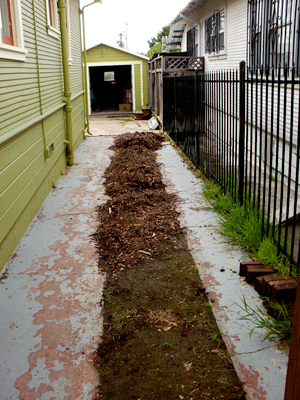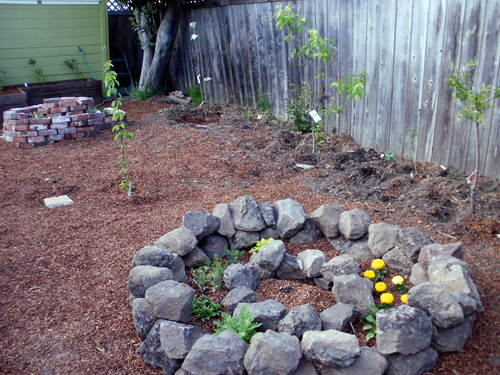But first, there was a whole lot of digging, hauling, and drilling to be done. The crew, old friends of Vickory and Carter's, were all women in their 40s, lured by the promise of "eating off the farm" once the garden was up and running. The first task? Building a raised bed along what was once the driveway, backed with wood slats, edged in with rocks and filled in with compost. Besides providing some 60 square feet of growing space, the heavy mulching alongside promised to cure the area's flooding problem by soaking up excess rain runoff from the roof and drain spouts. (A foot-deep catchment hole, filled in with mulch, was dug out right at the edge of the drain spout.)
By the time I arrived, the crew was busy ferrying rocks from truck to wheelbarrow to driveway. Once the rock wall was laid, we scooped, pushed, and dumped wheelbarrow after wheelbarrow of compost and mulch. Finally, the fun part: nestling in dozens of plants, from strawberries and bok choy to collards and cilantro. Suddenly, what was once just weedy concrete was the start of a food garden.
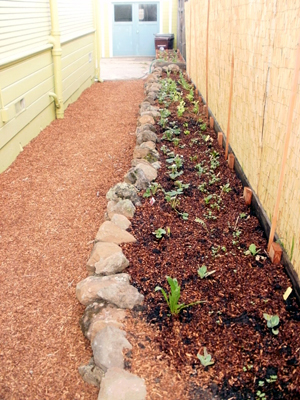
Raised bed on side of house. Photo by Sally Carter.
It was still only the beginning of a long, sweaty day. Having spent six months as an apprentice at Center for Agroecology and Sustainable Food Systems at UCSC, I knew how heavy a wheelbarrow full of compost gets--not to mention how long it takes to fill up, one shovelful at a time. Luckily, though, this was a crowd of can-do ladies (and butches), so the work got done, brick by brick and spade by spade.
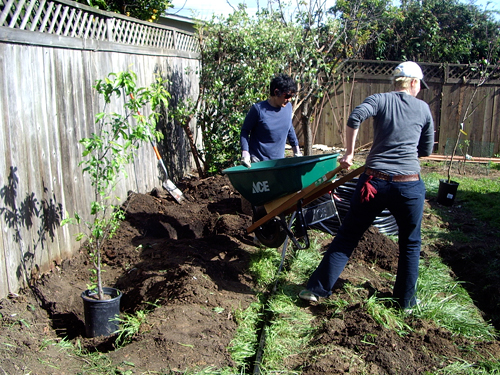
Susie and Heather using the wheelbarrow. Photo by Sally Carter.
Vickory, who practices somatic bodywork and Tantric counseling, and Carter, an elementary school teacher, weren't gardeners by nature. For several years, they'd been renting out their Oakland house while living in a high-rise apartment with a pretty view but no green space along Lake Merritt. Once they gave up the apartment and moved back into their house, however, Vickory found herself wondering how they could make their life there more productive and sustainable. Reading books like193339207X Food Not Lawns and Gaia's Garden, then hearing local urban farmer Novella Carpenter read from Farm City, her memoir of starting a micro-farm on an abandoned lot in East Oakland, made her look at their backyard in a new way. After all, she and Carter were already paying the mortgage on their green space; they wouldn't have to rely on the hopefully-benign neglect of an absentee landlord or city council.
And she liked the holistic concepts embodied in the idea of a permaculture system. It was a lot like Indian ideas of ayurveda, which she had been studying as part of a longtime spiritual practice. You didn't just stick some plants into the dirt, ply them with fertilizer and spray down the weeds and bugs with chemicals; instead, you took a whole-earth, whole-body approach, putting companionable plants together, choosing ornamentals whose nectar-producing flowers would support pollinating bees and wasps, building a whole small but self-sustaining ecosystem in which agriculture followed the dictates of nature, rather than the other way around.
At first, the couple planned to set up their edible garden themselves. They got several of their overgrown trees and shrubs heavily pruned back or removed.
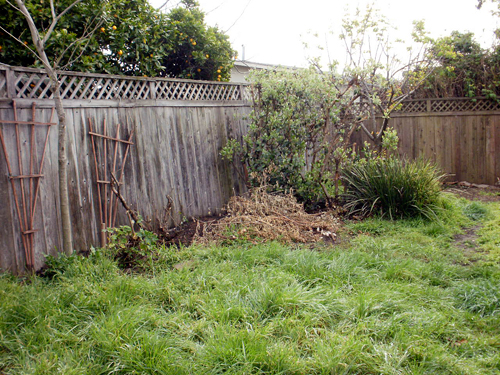
The yard before the Planting Justice transformation. Photo by Sally Carter
Now the yard was sunnier, but the bare spaces felt almost accusatory. OK, tree killer, they seemed to be saying. Now what? Then, at a local permaculture class, they met Gavin Raders, co-founder of Planting Justice.
A social-justice activist turned permaculture gardener, Raders and his partner Haleh Zandi had recently started Planting Justice as a non-profit group addressing urban food-security issues, one edible garden at a time. The high price of many permaculture workshops and installations--which pretty much insured access only to well-off, white-collar urbanites--seemed out of whack with permaculture's basic tenants of sustainability and self-sufficiency. Sure, hard-earned skills and knowledge should be valued, but shouldn't they also be shared? Planting Justice would try to do both, by offering garden design, installation, and support at a fair price while using the profits to support similar work in low-income communities. They looked for clients who were willing to become gardeners and partners in the process. The more labor a client could round up, the more affordable the garden installation would be.
Once Vickory and Carter heard that the price that they'd pay for their garden would help pay for another affordable garden elsewhere in Oakland, they signed up on the spot.
Meanwhile, back in the yard, pieces of salvaged redwood (preferred because it lasts forever and doesn't rot) were being sawed and drilled into long planters shaped to flank the deck. Sunshine that once just heated up a slab of concrete would soon be feeding blueberry bushes, tomatoes, zucchini, and greens. Once the planters were built, more compost comes in. We started the day kidding that Susie, a chiropractor, was just there to drum up new clients. By now, after umpteen wheelbarrow trips, her skills are starting to look pretty appealing.
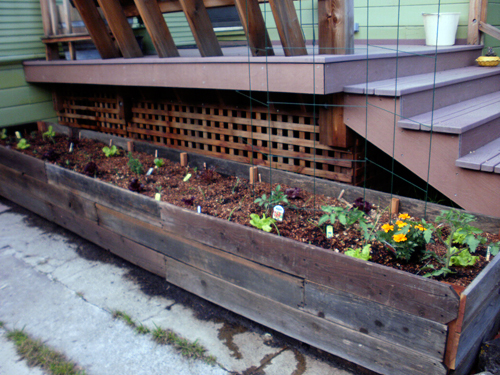
Planters shaped to flank the decks. Photo by Sally Carter.
At one p.m., it's time to break for hand-washing and lunch. A couple of zealous stragglers are bullied away from their shovels and brought inside. We clasp hands as Vickory recites a Hindu blessing in Sanskrit, expressing thanks to the earth, the spirits of creation, and all those whose work put the food on our table.
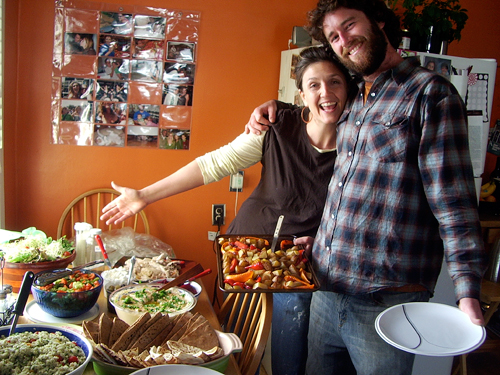
Christina and Gavin and the lunch spread.
Then we dig into hummus and salad (with sugar-snap peas and lettuce brought over from my own community-garden plot), roasted potatoes and carrots, pita bread and quinoa salad, crock-pot chicken, olives and feta, cool iced tea and white sangria, all made by Christina. Andrew, our greywater expert, notes that this is their first garden project not fueled by take-out burritos. The food is fantastic and gets us ready to dig holes for the dozen fruit trees that in a few years will be producing Dapple Dandy pluots, sweet cherries, Pink Lady and Fuji apples, pears and white peaches, mulberries, Meyer lemons and tangerines.
Raspberry canes go into a trench of compost behind the garage, next to the compost bin. Once the ivy is stripped from the back fence, it's replaced by thornless blackberry and boysenberry vines, fronted by squat bush beans. Elegant red currant and gooseberry plants go in alongside the trees. A rhubarb crown is planted specifically for me, I'm told, to be turned into pies, compotes, and jam.
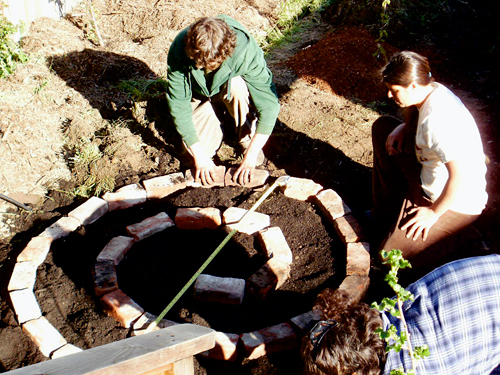
Building the herb spiral. Photo by Sally Carter.
At the foot of the deck steps, we learn to build an herb spiral, an ingenious way to squeeze a 25-foot strip of plantings into a five-foot-wide circle. Once the circle is marked, we use bricks and a measuring tape to lay out a gentle curve that coils inward in a one-foot-wide spiral. Seven bricks high at the center, it tapers down to three bricks high at the outer edge. Filled with soil and compost, it's planted with a range of culinary and medicinal herbs. Those that like it dry (woody Mediterranean plants like thyme, rosemary, and lavender) go at the top, while thirsty plants like parsley and cilantro go at the bottom. The idea? Water will run down through the soil, leaving the top plants dryer while soaking the lower ones.
It's pretty and surprisingly easy to build. Vickory is entranced, and now wants to build spirals for everything. Veggie spirals! Flower spirals! Tree spirals!
Finally, by seven p.m, we knock off for the day, toasting our work with beers and aching muscles. The work's nowhere near finished; Easter morning finds a smaller crew out in the rain, still digging and hauling. Although the original plan, including the greywater system, was projected to be in place in only two days, it takes the better part of a week to finish.
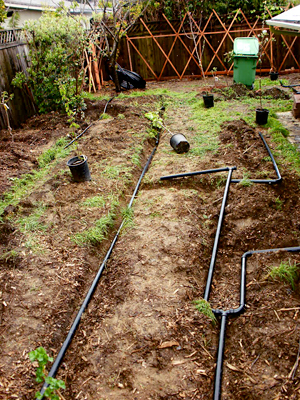
Greywater piping. Photo by Sally Carter.
The heavy clay soil, lumpy and uneven from all the dirt thrown up and trampled, had to be leveled with more digging. The last piles of mulch and compost have to be brought in off the street. More rocks are hauled in, to build a low wall along the edge of the front yard. Mulch is spread over what was once the front lawn, dotted with native perennials meant to create a living fence for both prettiness and privacy.
Exhausted yet satisfied, Vickory and Carter are still a little amazed at the transformation their week-long project has produced. And not just in their yard. As they hauled and dug, new neighbors stopped by to say hello. Old neighbors they'd never met came by, too, offering advice. One man told them that a guy up the street was a beekeeper, and might have honey to swap for vegetables.
Looking out at the long, tidy rows of vegetables ready to grow, we think about starting a tiny community supported agriculture (CSA) among the friends who'd helped out, trading weekly bags of vegetables for massages, say. Over bowls of veggie chili brought over by a neighbor, we toast the future of the garden, 3000 square feet of beautiful potential.
